Financial Reporting Analysis: Objectives, Standards, and Statements
VerifiedAdded on 2021/02/20
|15
|4303
|39
Report
AI Summary
This report provides a comprehensive analysis of financial reporting, beginning with its context and purpose, and then delving into the conceptual and regulatory frameworks, principles, and qualitative characteristics. It examines various stakeholders and the benefits they derive from financial information, and how financial reports are used to meet organizational growth and objectives. The report includes the presentation of financial statements, such as the profit and loss account, statement of changes in equity, and statement of financial position, along with working notes. It also covers the interpretation of financial statements of a FTSE 100 listed company, a comparison of International Accounting Standards (IAS) and International Financial Reporting Standards (IFRS), and the benefits and degree of compliance with IFRS across organizations worldwide. The report offers a detailed overview of financial reporting standards and their practical application.
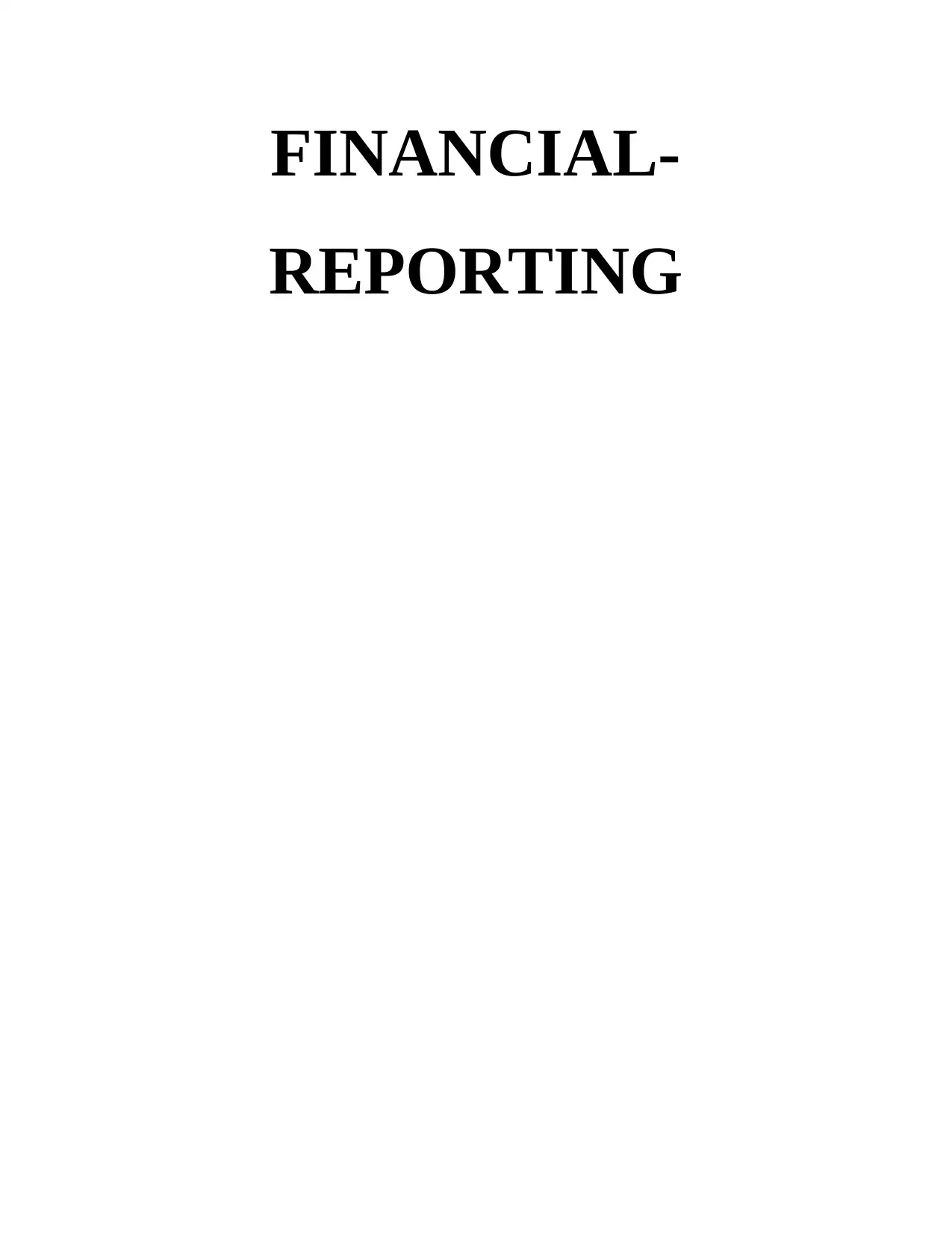
FINANCIAL-
REPORTING
REPORTING
Paraphrase This Document
Need a fresh take? Get an instant paraphrase of this document with our AI Paraphraser
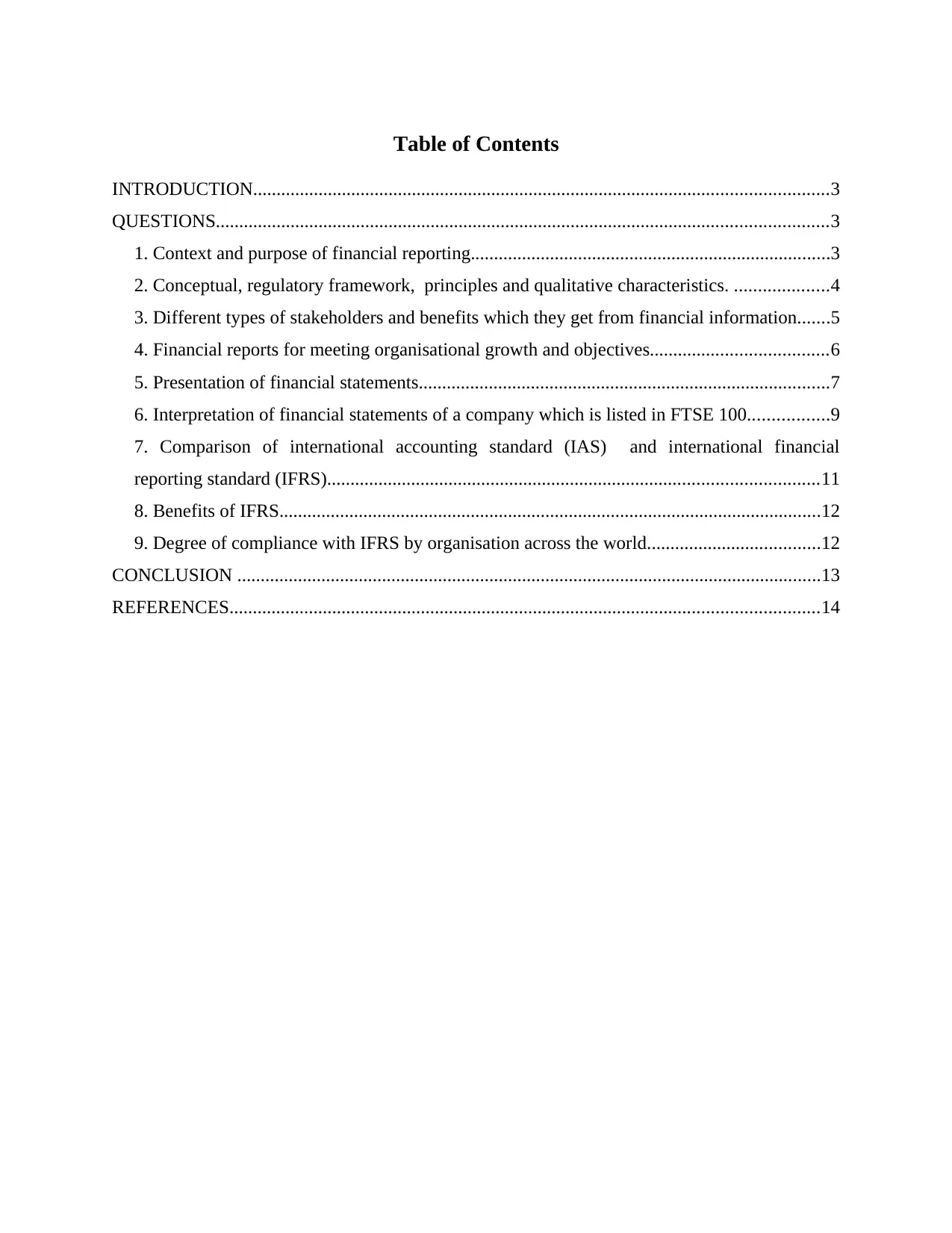
Table of Contents
INTRODUCTION...........................................................................................................................3
QUESTIONS...................................................................................................................................3
1. Context and purpose of financial reporting.............................................................................3
2. Conceptual, regulatory framework, principles and qualitative characteristics. ....................4
3. Different types of stakeholders and benefits which they get from financial information.......5
4. Financial reports for meeting organisational growth and objectives......................................6
5. Presentation of financial statements........................................................................................7
6. Interpretation of financial statements of a company which is listed in FTSE 100.................9
7. Comparison of international accounting standard (IAS) and international financial
reporting standard (IFRS).........................................................................................................11
8. Benefits of IFRS....................................................................................................................12
9. Degree of compliance with IFRS by organisation across the world.....................................12
CONCLUSION .............................................................................................................................13
REFERENCES..............................................................................................................................14
INTRODUCTION...........................................................................................................................3
QUESTIONS...................................................................................................................................3
1. Context and purpose of financial reporting.............................................................................3
2. Conceptual, regulatory framework, principles and qualitative characteristics. ....................4
3. Different types of stakeholders and benefits which they get from financial information.......5
4. Financial reports for meeting organisational growth and objectives......................................6
5. Presentation of financial statements........................................................................................7
6. Interpretation of financial statements of a company which is listed in FTSE 100.................9
7. Comparison of international accounting standard (IAS) and international financial
reporting standard (IFRS).........................................................................................................11
8. Benefits of IFRS....................................................................................................................12
9. Degree of compliance with IFRS by organisation across the world.....................................12
CONCLUSION .............................................................................................................................13
REFERENCES..............................................................................................................................14
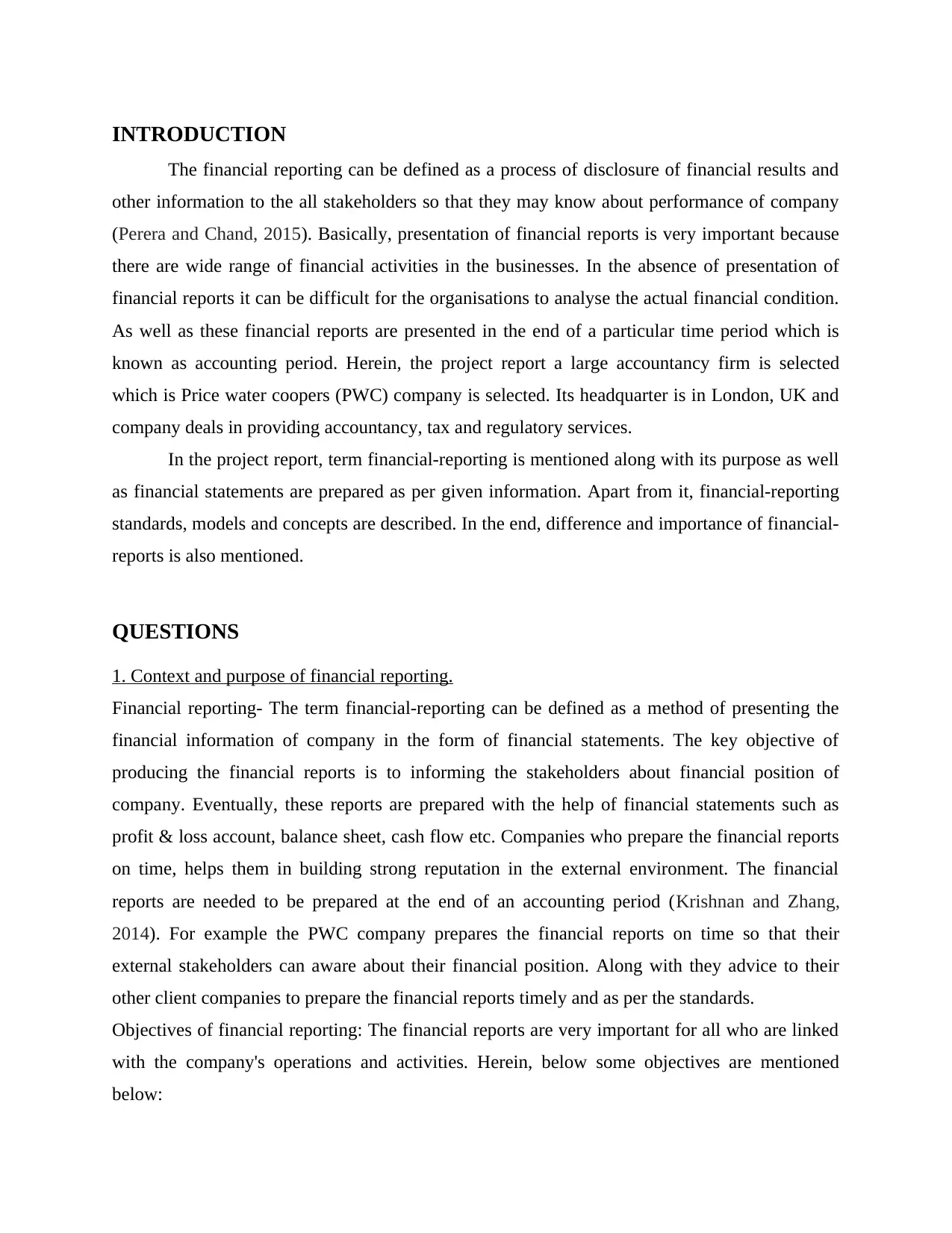
INTRODUCTION
The financial reporting can be defined as a process of disclosure of financial results and
other information to the all stakeholders so that they may know about performance of company
(Perera and Chand, 2015). Basically, presentation of financial reports is very important because
there are wide range of financial activities in the businesses. In the absence of presentation of
financial reports it can be difficult for the organisations to analyse the actual financial condition.
As well as these financial reports are presented in the end of a particular time period which is
known as accounting period. Herein, the project report a large accountancy firm is selected
which is Price water coopers (PWC) company is selected. Its headquarter is in London, UK and
company deals in providing accountancy, tax and regulatory services.
In the project report, term financial-reporting is mentioned along with its purpose as well
as financial statements are prepared as per given information. Apart from it, financial-reporting
standards, models and concepts are described. In the end, difference and importance of financial-
reports is also mentioned.
QUESTIONS
1. Context and purpose of financial reporting.
Financial reporting- The term financial-reporting can be defined as a method of presenting the
financial information of company in the form of financial statements. The key objective of
producing the financial reports is to informing the stakeholders about financial position of
company. Eventually, these reports are prepared with the help of financial statements such as
profit & loss account, balance sheet, cash flow etc. Companies who prepare the financial reports
on time, helps them in building strong reputation in the external environment. The financial
reports are needed to be prepared at the end of an accounting period (Krishnan and Zhang,
2014). For example the PWC company prepares the financial reports on time so that their
external stakeholders can aware about their financial position. Along with they advice to their
other client companies to prepare the financial reports timely and as per the standards.
Objectives of financial reporting: The financial reports are very important for all who are linked
with the company's operations and activities. Herein, below some objectives are mentioned
below:
The financial reporting can be defined as a process of disclosure of financial results and
other information to the all stakeholders so that they may know about performance of company
(Perera and Chand, 2015). Basically, presentation of financial reports is very important because
there are wide range of financial activities in the businesses. In the absence of presentation of
financial reports it can be difficult for the organisations to analyse the actual financial condition.
As well as these financial reports are presented in the end of a particular time period which is
known as accounting period. Herein, the project report a large accountancy firm is selected
which is Price water coopers (PWC) company is selected. Its headquarter is in London, UK and
company deals in providing accountancy, tax and regulatory services.
In the project report, term financial-reporting is mentioned along with its purpose as well
as financial statements are prepared as per given information. Apart from it, financial-reporting
standards, models and concepts are described. In the end, difference and importance of financial-
reports is also mentioned.
QUESTIONS
1. Context and purpose of financial reporting.
Financial reporting- The term financial-reporting can be defined as a method of presenting the
financial information of company in the form of financial statements. The key objective of
producing the financial reports is to informing the stakeholders about financial position of
company. Eventually, these reports are prepared with the help of financial statements such as
profit & loss account, balance sheet, cash flow etc. Companies who prepare the financial reports
on time, helps them in building strong reputation in the external environment. The financial
reports are needed to be prepared at the end of an accounting period (Krishnan and Zhang,
2014). For example the PWC company prepares the financial reports on time so that their
external stakeholders can aware about their financial position. Along with they advice to their
other client companies to prepare the financial reports timely and as per the standards.
Objectives of financial reporting: The financial reports are very important for all who are linked
with the company's operations and activities. Herein, below some objectives are mentioned
below:
⊘ This is a preview!⊘
Do you want full access?
Subscribe today to unlock all pages.

Trusted by 1+ million students worldwide
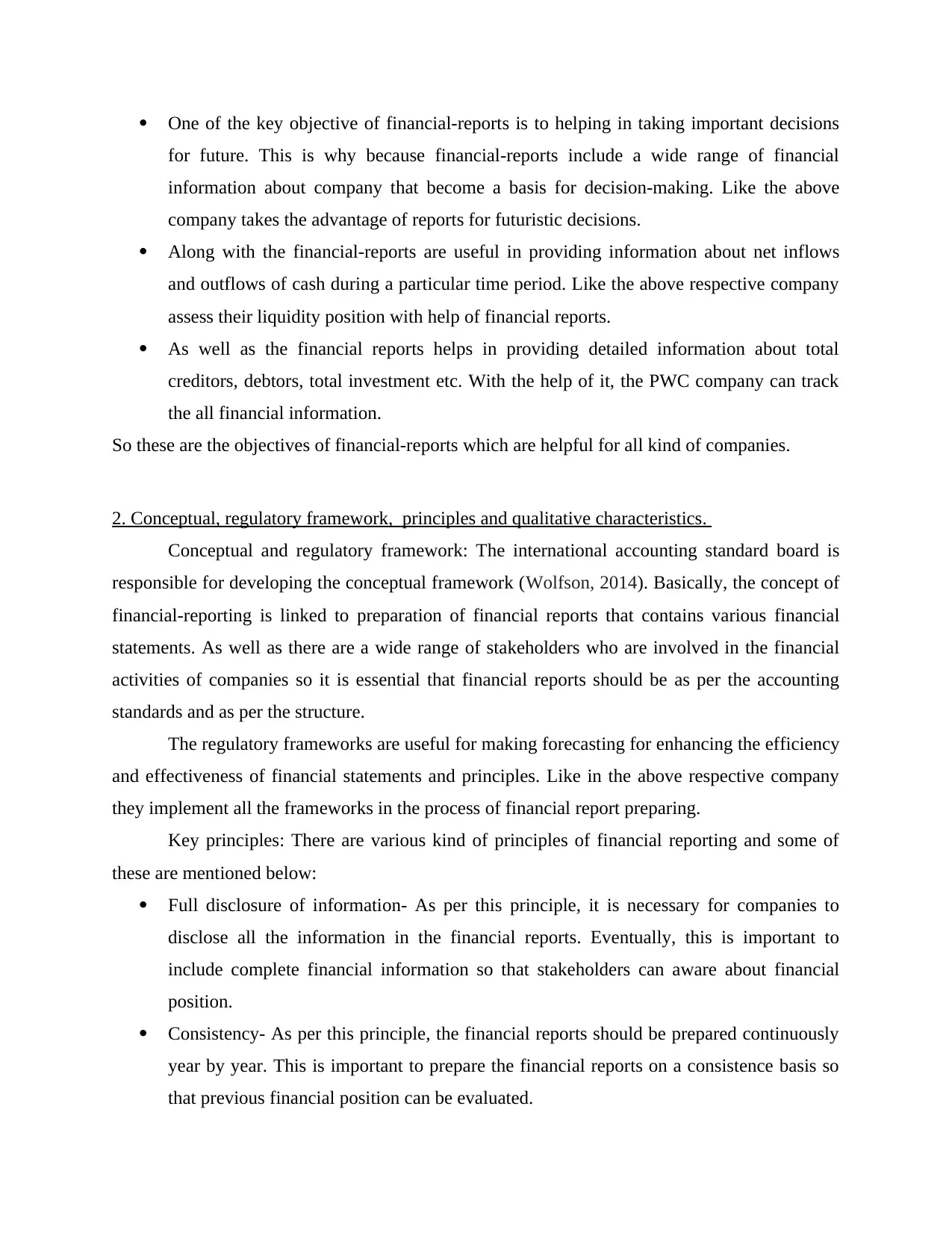
One of the key objective of financial-reports is to helping in taking important decisions
for future. This is why because financial-reports include a wide range of financial
information about company that become a basis for decision-making. Like the above
company takes the advantage of reports for futuristic decisions.
Along with the financial-reports are useful in providing information about net inflows
and outflows of cash during a particular time period. Like the above respective company
assess their liquidity position with help of financial reports.
As well as the financial reports helps in providing detailed information about total
creditors, debtors, total investment etc. With the help of it, the PWC company can track
the all financial information.
So these are the objectives of financial-reports which are helpful for all kind of companies.
2. Conceptual, regulatory framework, principles and qualitative characteristics.
Conceptual and regulatory framework: The international accounting standard board is
responsible for developing the conceptual framework (Wolfson, 2014). Basically, the concept of
financial-reporting is linked to preparation of financial reports that contains various financial
statements. As well as there are a wide range of stakeholders who are involved in the financial
activities of companies so it is essential that financial reports should be as per the accounting
standards and as per the structure.
The regulatory frameworks are useful for making forecasting for enhancing the efficiency
and effectiveness of financial statements and principles. Like in the above respective company
they implement all the frameworks in the process of financial report preparing.
Key principles: There are various kind of principles of financial reporting and some of
these are mentioned below:
Full disclosure of information- As per this principle, it is necessary for companies to
disclose all the information in the financial reports. Eventually, this is important to
include complete financial information so that stakeholders can aware about financial
position.
Consistency- As per this principle, the financial reports should be prepared continuously
year by year. This is important to prepare the financial reports on a consistence basis so
that previous financial position can be evaluated.
for future. This is why because financial-reports include a wide range of financial
information about company that become a basis for decision-making. Like the above
company takes the advantage of reports for futuristic decisions.
Along with the financial-reports are useful in providing information about net inflows
and outflows of cash during a particular time period. Like the above respective company
assess their liquidity position with help of financial reports.
As well as the financial reports helps in providing detailed information about total
creditors, debtors, total investment etc. With the help of it, the PWC company can track
the all financial information.
So these are the objectives of financial-reports which are helpful for all kind of companies.
2. Conceptual, regulatory framework, principles and qualitative characteristics.
Conceptual and regulatory framework: The international accounting standard board is
responsible for developing the conceptual framework (Wolfson, 2014). Basically, the concept of
financial-reporting is linked to preparation of financial reports that contains various financial
statements. As well as there are a wide range of stakeholders who are involved in the financial
activities of companies so it is essential that financial reports should be as per the accounting
standards and as per the structure.
The regulatory frameworks are useful for making forecasting for enhancing the efficiency
and effectiveness of financial statements and principles. Like in the above respective company
they implement all the frameworks in the process of financial report preparing.
Key principles: There are various kind of principles of financial reporting and some of
these are mentioned below:
Full disclosure of information- As per this principle, it is necessary for companies to
disclose all the information in the financial reports. Eventually, this is important to
include complete financial information so that stakeholders can aware about financial
position.
Consistency- As per this principle, the financial reports should be prepared continuously
year by year. This is important to prepare the financial reports on a consistence basis so
that previous financial position can be evaluated.
Paraphrase This Document
Need a fresh take? Get an instant paraphrase of this document with our AI Paraphraser
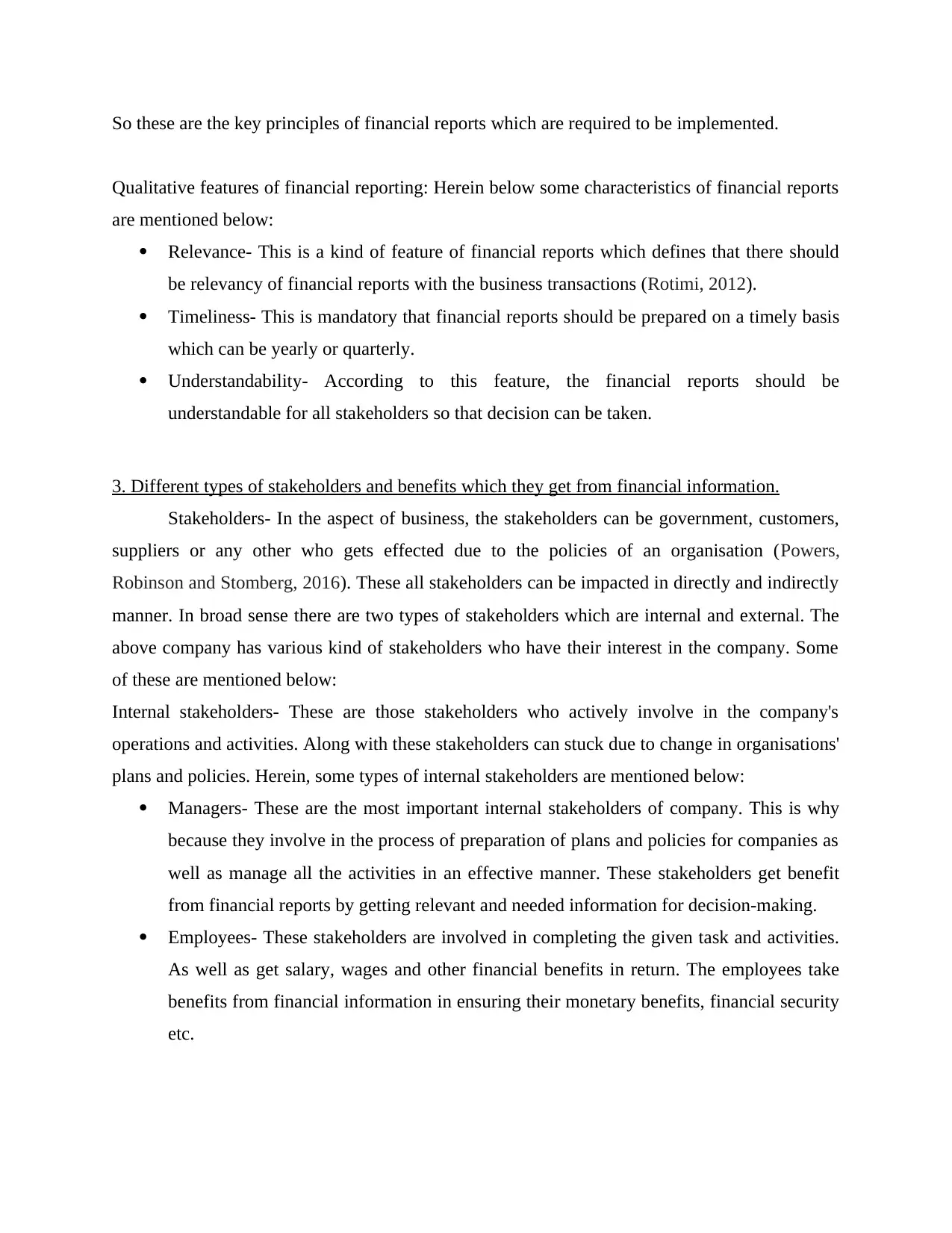
So these are the key principles of financial reports which are required to be implemented.
Qualitative features of financial reporting: Herein below some characteristics of financial reports
are mentioned below:
Relevance- This is a kind of feature of financial reports which defines that there should
be relevancy of financial reports with the business transactions (Rotimi, 2012).
Timeliness- This is mandatory that financial reports should be prepared on a timely basis
which can be yearly or quarterly.
Understandability- According to this feature, the financial reports should be
understandable for all stakeholders so that decision can be taken.
3. Different types of stakeholders and benefits which they get from financial information.
Stakeholders- In the aspect of business, the stakeholders can be government, customers,
suppliers or any other who gets effected due to the policies of an organisation (Powers,
Robinson and Stomberg, 2016). These all stakeholders can be impacted in directly and indirectly
manner. In broad sense there are two types of stakeholders which are internal and external. The
above company has various kind of stakeholders who have their interest in the company. Some
of these are mentioned below:
Internal stakeholders- These are those stakeholders who actively involve in the company's
operations and activities. Along with these stakeholders can stuck due to change in organisations'
plans and policies. Herein, some types of internal stakeholders are mentioned below:
Managers- These are the most important internal stakeholders of company. This is why
because they involve in the process of preparation of plans and policies for companies as
well as manage all the activities in an effective manner. These stakeholders get benefit
from financial reports by getting relevant and needed information for decision-making.
Employees- These stakeholders are involved in completing the given task and activities.
As well as get salary, wages and other financial benefits in return. The employees take
benefits from financial information in ensuring their monetary benefits, financial security
etc.
Qualitative features of financial reporting: Herein below some characteristics of financial reports
are mentioned below:
Relevance- This is a kind of feature of financial reports which defines that there should
be relevancy of financial reports with the business transactions (Rotimi, 2012).
Timeliness- This is mandatory that financial reports should be prepared on a timely basis
which can be yearly or quarterly.
Understandability- According to this feature, the financial reports should be
understandable for all stakeholders so that decision can be taken.
3. Different types of stakeholders and benefits which they get from financial information.
Stakeholders- In the aspect of business, the stakeholders can be government, customers,
suppliers or any other who gets effected due to the policies of an organisation (Powers,
Robinson and Stomberg, 2016). These all stakeholders can be impacted in directly and indirectly
manner. In broad sense there are two types of stakeholders which are internal and external. The
above company has various kind of stakeholders who have their interest in the company. Some
of these are mentioned below:
Internal stakeholders- These are those stakeholders who actively involve in the company's
operations and activities. Along with these stakeholders can stuck due to change in organisations'
plans and policies. Herein, some types of internal stakeholders are mentioned below:
Managers- These are the most important internal stakeholders of company. This is why
because they involve in the process of preparation of plans and policies for companies as
well as manage all the activities in an effective manner. These stakeholders get benefit
from financial reports by getting relevant and needed information for decision-making.
Employees- These stakeholders are involved in completing the given task and activities.
As well as get salary, wages and other financial benefits in return. The employees take
benefits from financial information in ensuring their monetary benefits, financial security
etc.
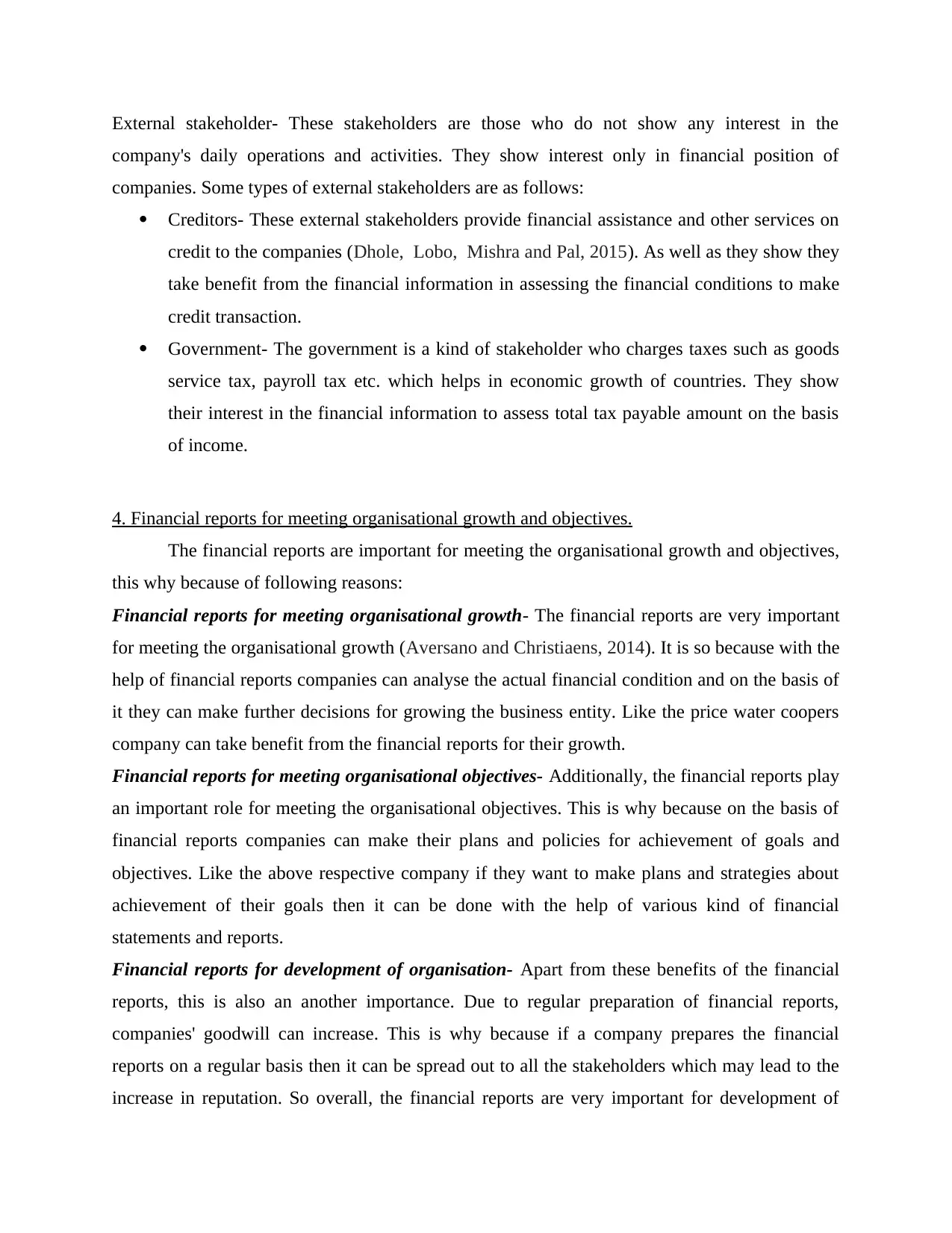
External stakeholder- These stakeholders are those who do not show any interest in the
company's daily operations and activities. They show interest only in financial position of
companies. Some types of external stakeholders are as follows:
Creditors- These external stakeholders provide financial assistance and other services on
credit to the companies (Dhole, Lobo, Mishra and Pal, 2015). As well as they show they
take benefit from the financial information in assessing the financial conditions to make
credit transaction.
Government- The government is a kind of stakeholder who charges taxes such as goods
service tax, payroll tax etc. which helps in economic growth of countries. They show
their interest in the financial information to assess total tax payable amount on the basis
of income.
4. Financial reports for meeting organisational growth and objectives.
The financial reports are important for meeting the organisational growth and objectives,
this why because of following reasons:
Financial reports for meeting organisational growth- The financial reports are very important
for meeting the organisational growth (Aversano and Christiaens, 2014). It is so because with the
help of financial reports companies can analyse the actual financial condition and on the basis of
it they can make further decisions for growing the business entity. Like the price water coopers
company can take benefit from the financial reports for their growth.
Financial reports for meeting organisational objectives- Additionally, the financial reports play
an important role for meeting the organisational objectives. This is why because on the basis of
financial reports companies can make their plans and policies for achievement of goals and
objectives. Like the above respective company if they want to make plans and strategies about
achievement of their goals then it can be done with the help of various kind of financial
statements and reports.
Financial reports for development of organisation- Apart from these benefits of the financial
reports, this is also an another importance. Due to regular preparation of financial reports,
companies' goodwill can increase. This is why because if a company prepares the financial
reports on a regular basis then it can be spread out to all the stakeholders which may lead to the
increase in reputation. So overall, the financial reports are very important for development of
company's daily operations and activities. They show interest only in financial position of
companies. Some types of external stakeholders are as follows:
Creditors- These external stakeholders provide financial assistance and other services on
credit to the companies (Dhole, Lobo, Mishra and Pal, 2015). As well as they show they
take benefit from the financial information in assessing the financial conditions to make
credit transaction.
Government- The government is a kind of stakeholder who charges taxes such as goods
service tax, payroll tax etc. which helps in economic growth of countries. They show
their interest in the financial information to assess total tax payable amount on the basis
of income.
4. Financial reports for meeting organisational growth and objectives.
The financial reports are important for meeting the organisational growth and objectives,
this why because of following reasons:
Financial reports for meeting organisational growth- The financial reports are very important
for meeting the organisational growth (Aversano and Christiaens, 2014). It is so because with the
help of financial reports companies can analyse the actual financial condition and on the basis of
it they can make further decisions for growing the business entity. Like the price water coopers
company can take benefit from the financial reports for their growth.
Financial reports for meeting organisational objectives- Additionally, the financial reports play
an important role for meeting the organisational objectives. This is why because on the basis of
financial reports companies can make their plans and policies for achievement of goals and
objectives. Like the above respective company if they want to make plans and strategies about
achievement of their goals then it can be done with the help of various kind of financial
statements and reports.
Financial reports for development of organisation- Apart from these benefits of the financial
reports, this is also an another importance. Due to regular preparation of financial reports,
companies' goodwill can increase. This is why because if a company prepares the financial
reports on a regular basis then it can be spread out to all the stakeholders which may lead to the
increase in reputation. So overall, the financial reports are very important for development of
⊘ This is a preview!⊘
Do you want full access?
Subscribe today to unlock all pages.

Trusted by 1+ million students worldwide
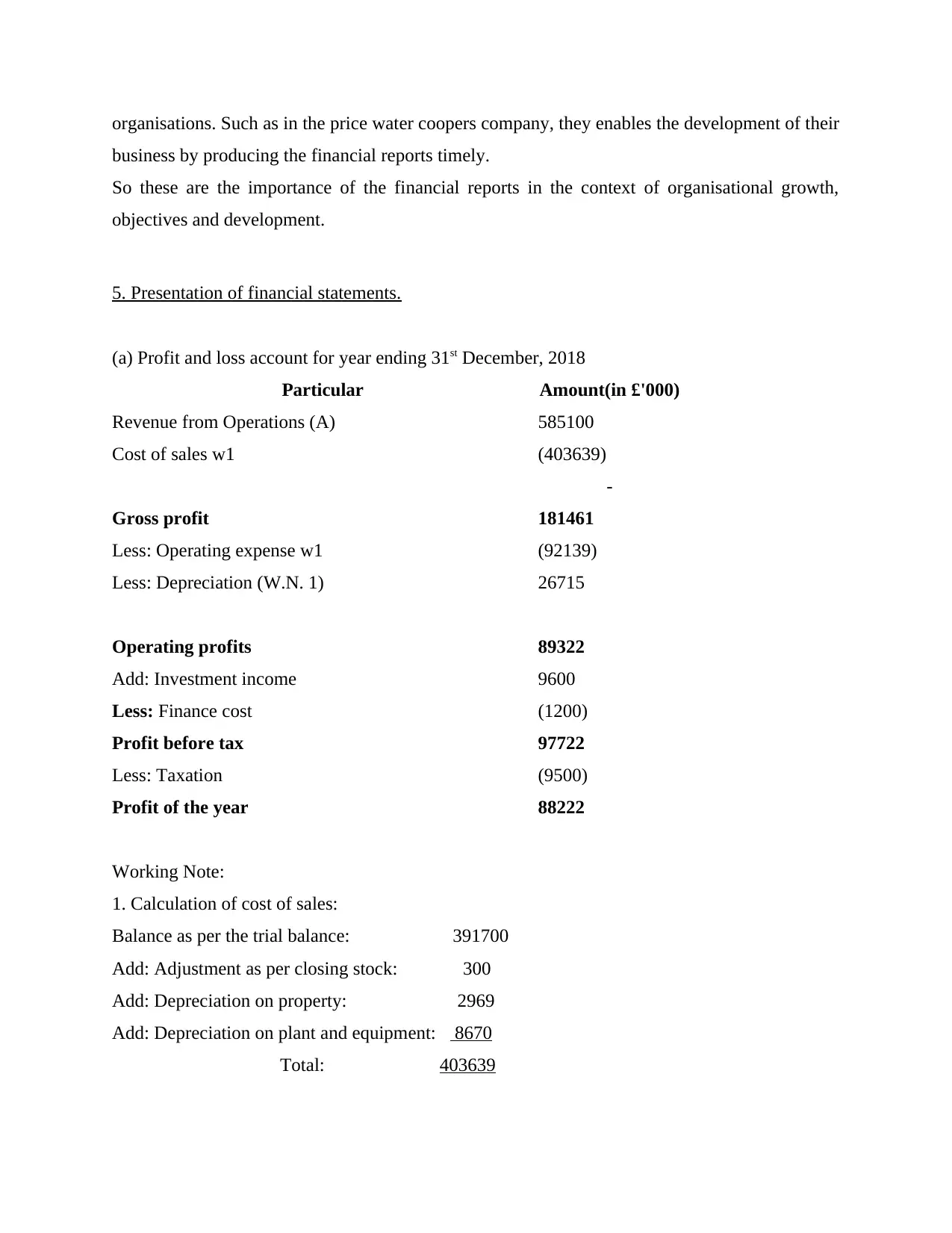
organisations. Such as in the price water coopers company, they enables the development of their
business by producing the financial reports timely.
So these are the importance of the financial reports in the context of organisational growth,
objectives and development.
5. Presentation of financial statements.
(a) Profit and loss account for year ending 31st December, 2018
Particular Amount(in £'000)
Revenue from Operations (A) 585100
Cost of sales w1 (403639)
-
Gross profit 181461
Less: Operating expense w1 (92139)
Less: Depreciation (W.N. 1) 26715
Operating profits 89322
Add: Investment income 9600
Less: Finance cost (1200)
Profit before tax 97722
Less: Taxation (9500)
Profit of the year 88222
Working Note:
1. Calculation of cost of sales:
Balance as per the trial balance: 391700
Add: Adjustment as per closing stock: 300
Add: Depreciation on property: 2969
Add: Depreciation on plant and equipment: 8670
Total: 403639
business by producing the financial reports timely.
So these are the importance of the financial reports in the context of organisational growth,
objectives and development.
5. Presentation of financial statements.
(a) Profit and loss account for year ending 31st December, 2018
Particular Amount(in £'000)
Revenue from Operations (A) 585100
Cost of sales w1 (403639)
-
Gross profit 181461
Less: Operating expense w1 (92139)
Less: Depreciation (W.N. 1) 26715
Operating profits 89322
Add: Investment income 9600
Less: Finance cost (1200)
Profit before tax 97722
Less: Taxation (9500)
Profit of the year 88222
Working Note:
1. Calculation of cost of sales:
Balance as per the trial balance: 391700
Add: Adjustment as per closing stock: 300
Add: Depreciation on property: 2969
Add: Depreciation on plant and equipment: 8670
Total: 403639
Paraphrase This Document
Need a fresh take? Get an instant paraphrase of this document with our AI Paraphraser
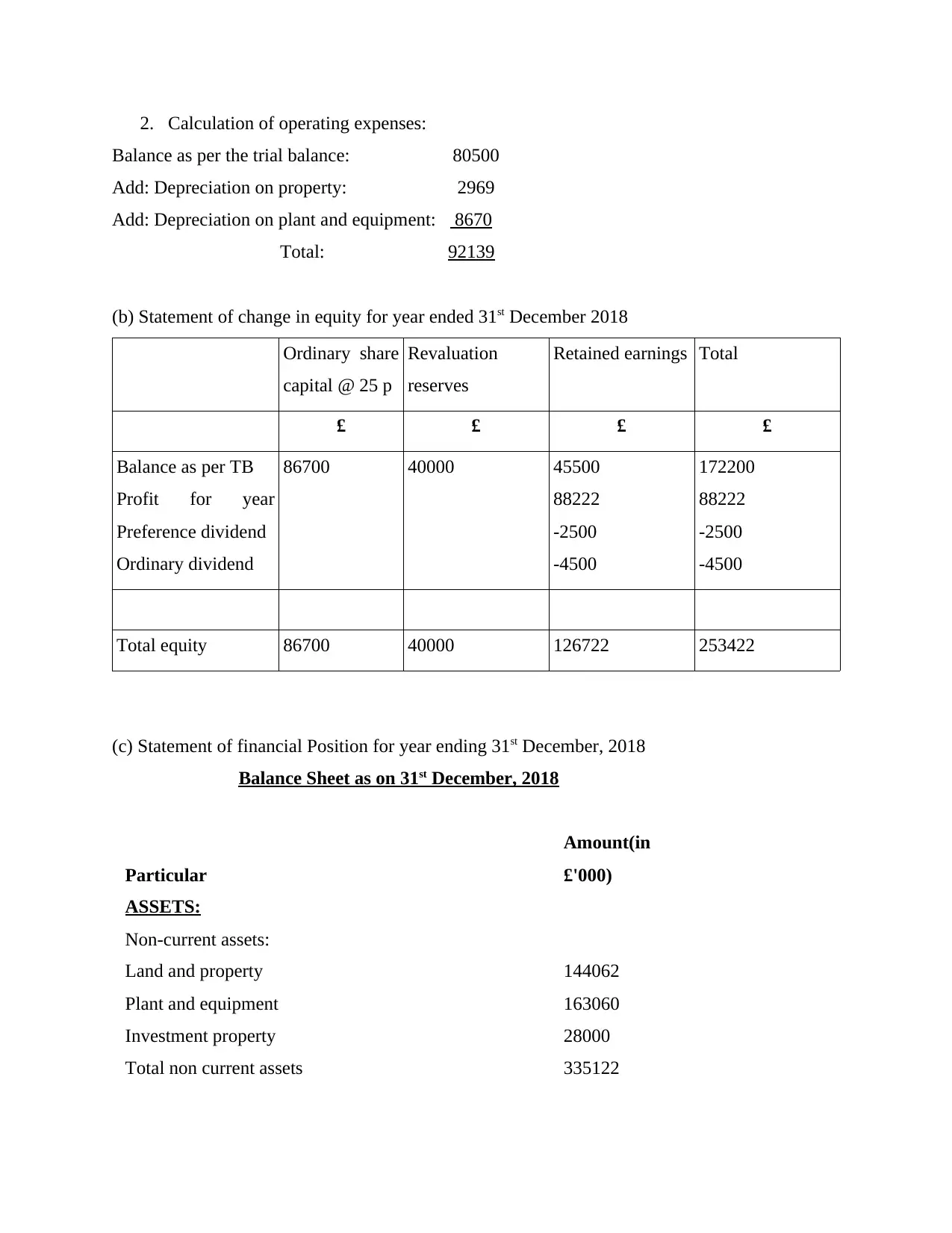
2. Calculation of operating expenses:
Balance as per the trial balance: 80500
Add: Depreciation on property: 2969
Add: Depreciation on plant and equipment: 8670
Total: 92139
(b) Statement of change in equity for year ended 31st December 2018
Ordinary share
capital @ 25 p
Revaluation
reserves
Retained earnings Total
£ £ £ £
Balance as per TB
Profit for year
Preference dividend
Ordinary dividend
86700 40000 45500
88222
-2500
-4500
172200
88222
-2500
-4500
Total equity 86700 40000 126722 253422
(c) Statement of financial Position for year ending 31st December, 2018
Balance Sheet as on 31st December, 2018
Particular
Amount(in
£'000)
ASSETS:
Non-current assets:
Land and property 144062
Plant and equipment 163060
Investment property 28000
Total non current assets 335122
Balance as per the trial balance: 80500
Add: Depreciation on property: 2969
Add: Depreciation on plant and equipment: 8670
Total: 92139
(b) Statement of change in equity for year ended 31st December 2018
Ordinary share
capital @ 25 p
Revaluation
reserves
Retained earnings Total
£ £ £ £
Balance as per TB
Profit for year
Preference dividend
Ordinary dividend
86700 40000 45500
88222
-2500
-4500
172200
88222
-2500
-4500
Total equity 86700 40000 126722 253422
(c) Statement of financial Position for year ending 31st December, 2018
Balance Sheet as on 31st December, 2018
Particular
Amount(in
£'000)
ASSETS:
Non-current assets:
Land and property 144062
Plant and equipment 163060
Investment property 28000
Total non current assets 335122
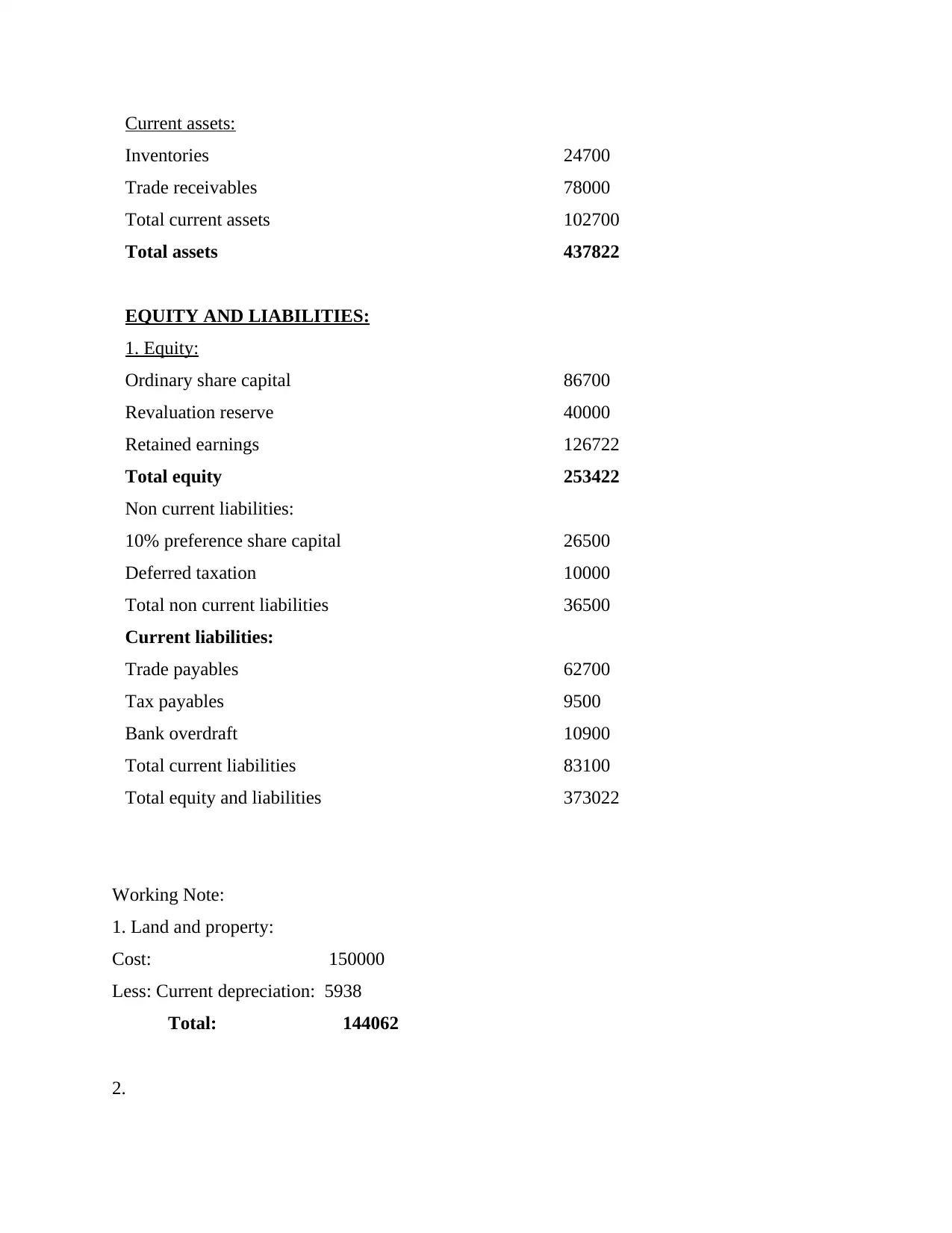
Current assets:
Inventories 24700
Trade receivables 78000
Total current assets 102700
Total assets 437822
EQUITY AND LIABILITIES:
1. Equity:
Ordinary share capital 86700
Revaluation reserve 40000
Retained earnings 126722
Total equity 253422
Non current liabilities:
10% preference share capital 26500
Deferred taxation 10000
Total non current liabilities 36500
Current liabilities:
Trade payables 62700
Tax payables 9500
Bank overdraft 10900
Total current liabilities 83100
Total equity and liabilities 373022
Working Note:
1. Land and property:
Cost: 150000
Less: Current depreciation: 5938
Total: 144062
2.
Inventories 24700
Trade receivables 78000
Total current assets 102700
Total assets 437822
EQUITY AND LIABILITIES:
1. Equity:
Ordinary share capital 86700
Revaluation reserve 40000
Retained earnings 126722
Total equity 253422
Non current liabilities:
10% preference share capital 26500
Deferred taxation 10000
Total non current liabilities 36500
Current liabilities:
Trade payables 62700
Tax payables 9500
Bank overdraft 10900
Total current liabilities 83100
Total equity and liabilities 373022
Working Note:
1. Land and property:
Cost: 150000
Less: Current depreciation: 5938
Total: 144062
2.
⊘ This is a preview!⊘
Do you want full access?
Subscribe today to unlock all pages.

Trusted by 1+ million students worldwide
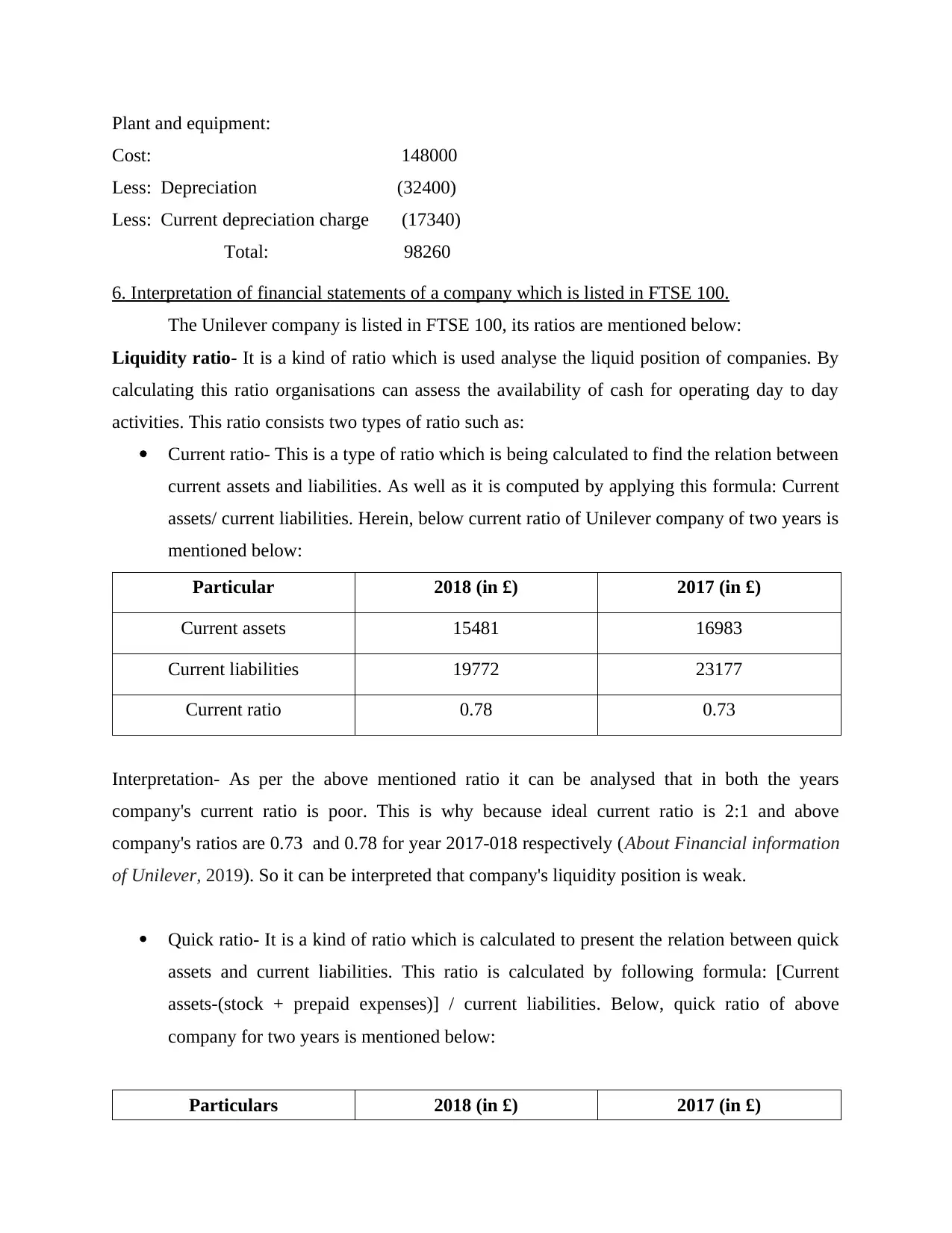
Plant and equipment:
Cost: 148000
Less: Depreciation (32400)
Less: Current depreciation charge (17340)
Total: 98260
6. Interpretation of financial statements of a company which is listed in FTSE 100.
The Unilever company is listed in FTSE 100, its ratios are mentioned below:
Liquidity ratio- It is a kind of ratio which is used analyse the liquid position of companies. By
calculating this ratio organisations can assess the availability of cash for operating day to day
activities. This ratio consists two types of ratio such as:
Current ratio- This is a type of ratio which is being calculated to find the relation between
current assets and liabilities. As well as it is computed by applying this formula: Current
assets/ current liabilities. Herein, below current ratio of Unilever company of two years is
mentioned below:
Particular 2018 (in £) 2017 (in £)
Current assets 15481 16983
Current liabilities 19772 23177
Current ratio 0.78 0.73
Interpretation- As per the above mentioned ratio it can be analysed that in both the years
company's current ratio is poor. This is why because ideal current ratio is 2:1 and above
company's ratios are 0.73 and 0.78 for year 2017-018 respectively (About Financial information
of Unilever, 2019). So it can be interpreted that company's liquidity position is weak.
Quick ratio- It is a kind of ratio which is calculated to present the relation between quick
assets and current liabilities. This ratio is calculated by following formula: [Current
assets-(stock + prepaid expenses)] / current liabilities. Below, quick ratio of above
company for two years is mentioned below:
Particulars 2018 (in £) 2017 (in £)
Cost: 148000
Less: Depreciation (32400)
Less: Current depreciation charge (17340)
Total: 98260
6. Interpretation of financial statements of a company which is listed in FTSE 100.
The Unilever company is listed in FTSE 100, its ratios are mentioned below:
Liquidity ratio- It is a kind of ratio which is used analyse the liquid position of companies. By
calculating this ratio organisations can assess the availability of cash for operating day to day
activities. This ratio consists two types of ratio such as:
Current ratio- This is a type of ratio which is being calculated to find the relation between
current assets and liabilities. As well as it is computed by applying this formula: Current
assets/ current liabilities. Herein, below current ratio of Unilever company of two years is
mentioned below:
Particular 2018 (in £) 2017 (in £)
Current assets 15481 16983
Current liabilities 19772 23177
Current ratio 0.78 0.73
Interpretation- As per the above mentioned ratio it can be analysed that in both the years
company's current ratio is poor. This is why because ideal current ratio is 2:1 and above
company's ratios are 0.73 and 0.78 for year 2017-018 respectively (About Financial information
of Unilever, 2019). So it can be interpreted that company's liquidity position is weak.
Quick ratio- It is a kind of ratio which is calculated to present the relation between quick
assets and current liabilities. This ratio is calculated by following formula: [Current
assets-(stock + prepaid expenses)] / current liabilities. Below, quick ratio of above
company for two years is mentioned below:
Particulars 2018 (in £) 2017 (in £)
Paraphrase This Document
Need a fresh take? Get an instant paraphrase of this document with our AI Paraphraser
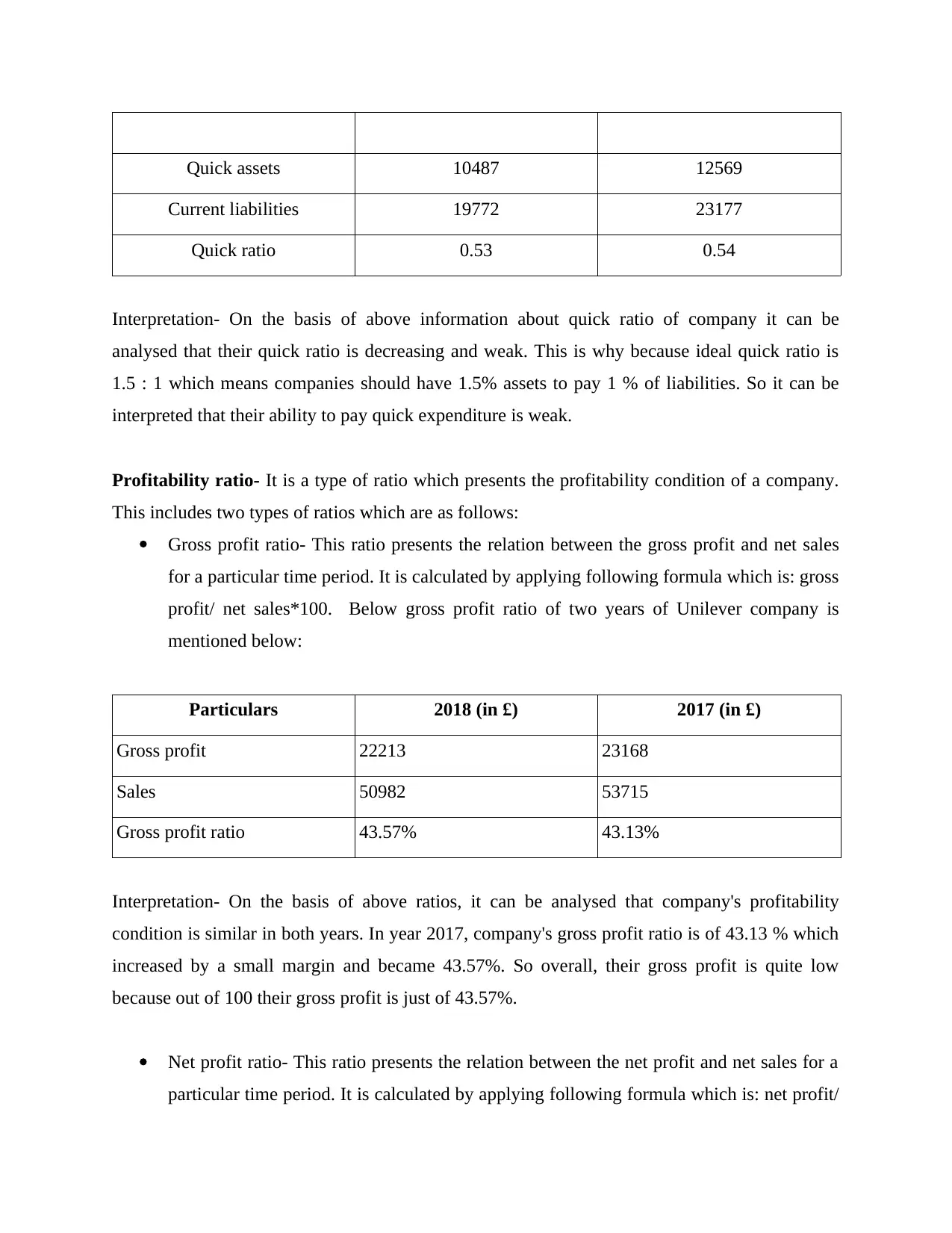
Quick assets 10487 12569
Current liabilities 19772 23177
Quick ratio 0.53 0.54
Interpretation- On the basis of above information about quick ratio of company it can be
analysed that their quick ratio is decreasing and weak. This is why because ideal quick ratio is
1.5 : 1 which means companies should have 1.5% assets to pay 1 % of liabilities. So it can be
interpreted that their ability to pay quick expenditure is weak.
Profitability ratio- It is a type of ratio which presents the profitability condition of a company.
This includes two types of ratios which are as follows:
Gross profit ratio- This ratio presents the relation between the gross profit and net sales
for a particular time period. It is calculated by applying following formula which is: gross
profit/ net sales*100. Below gross profit ratio of two years of Unilever company is
mentioned below:
Particulars 2018 (in £) 2017 (in £)
Gross profit 22213 23168
Sales 50982 53715
Gross profit ratio 43.57% 43.13%
Interpretation- On the basis of above ratios, it can be analysed that company's profitability
condition is similar in both years. In year 2017, company's gross profit ratio is of 43.13 % which
increased by a small margin and became 43.57%. So overall, their gross profit is quite low
because out of 100 their gross profit is just of 43.57%.
Net profit ratio- This ratio presents the relation between the net profit and net sales for a
particular time period. It is calculated by applying following formula which is: net profit/
Current liabilities 19772 23177
Quick ratio 0.53 0.54
Interpretation- On the basis of above information about quick ratio of company it can be
analysed that their quick ratio is decreasing and weak. This is why because ideal quick ratio is
1.5 : 1 which means companies should have 1.5% assets to pay 1 % of liabilities. So it can be
interpreted that their ability to pay quick expenditure is weak.
Profitability ratio- It is a type of ratio which presents the profitability condition of a company.
This includes two types of ratios which are as follows:
Gross profit ratio- This ratio presents the relation between the gross profit and net sales
for a particular time period. It is calculated by applying following formula which is: gross
profit/ net sales*100. Below gross profit ratio of two years of Unilever company is
mentioned below:
Particulars 2018 (in £) 2017 (in £)
Gross profit 22213 23168
Sales 50982 53715
Gross profit ratio 43.57% 43.13%
Interpretation- On the basis of above ratios, it can be analysed that company's profitability
condition is similar in both years. In year 2017, company's gross profit ratio is of 43.13 % which
increased by a small margin and became 43.57%. So overall, their gross profit is quite low
because out of 100 their gross profit is just of 43.57%.
Net profit ratio- This ratio presents the relation between the net profit and net sales for a
particular time period. It is calculated by applying following formula which is: net profit/
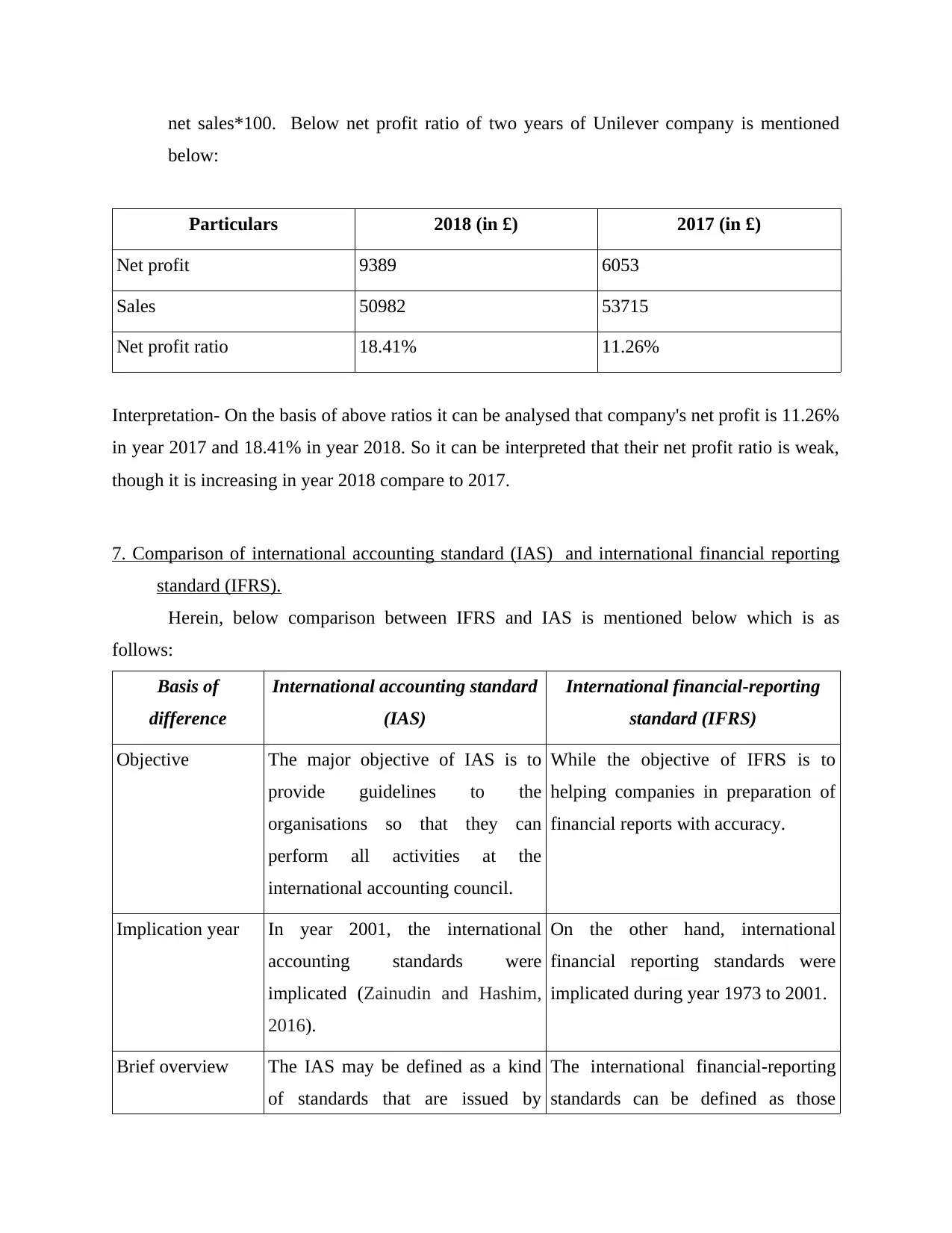
net sales*100. Below net profit ratio of two years of Unilever company is mentioned
below:
Particulars 2018 (in £) 2017 (in £)
Net profit 9389 6053
Sales 50982 53715
Net profit ratio 18.41% 11.26%
Interpretation- On the basis of above ratios it can be analysed that company's net profit is 11.26%
in year 2017 and 18.41% in year 2018. So it can be interpreted that their net profit ratio is weak,
though it is increasing in year 2018 compare to 2017.
7. Comparison of international accounting standard (IAS) and international financial reporting
standard (IFRS).
Herein, below comparison between IFRS and IAS is mentioned below which is as
follows:
Basis of
difference
International accounting standard
(IAS)
International financial-reporting
standard (IFRS)
Objective The major objective of IAS is to
provide guidelines to the
organisations so that they can
perform all activities at the
international accounting council.
While the objective of IFRS is to
helping companies in preparation of
financial reports with accuracy.
Implication year In year 2001, the international
accounting standards were
implicated (Zainudin and Hashim,
2016).
On the other hand, international
financial reporting standards were
implicated during year 1973 to 2001.
Brief overview The IAS may be defined as a kind
of standards that are issued by
The international financial-reporting
standards can be defined as those
below:
Particulars 2018 (in £) 2017 (in £)
Net profit 9389 6053
Sales 50982 53715
Net profit ratio 18.41% 11.26%
Interpretation- On the basis of above ratios it can be analysed that company's net profit is 11.26%
in year 2017 and 18.41% in year 2018. So it can be interpreted that their net profit ratio is weak,
though it is increasing in year 2018 compare to 2017.
7. Comparison of international accounting standard (IAS) and international financial reporting
standard (IFRS).
Herein, below comparison between IFRS and IAS is mentioned below which is as
follows:
Basis of
difference
International accounting standard
(IAS)
International financial-reporting
standard (IFRS)
Objective The major objective of IAS is to
provide guidelines to the
organisations so that they can
perform all activities at the
international accounting council.
While the objective of IFRS is to
helping companies in preparation of
financial reports with accuracy.
Implication year In year 2001, the international
accounting standards were
implicated (Zainudin and Hashim,
2016).
On the other hand, international
financial reporting standards were
implicated during year 1973 to 2001.
Brief overview The IAS may be defined as a kind
of standards that are issued by
The international financial-reporting
standards can be defined as those
⊘ This is a preview!⊘
Do you want full access?
Subscribe today to unlock all pages.

Trusted by 1+ million students worldwide
1 out of 15
Related Documents
Your All-in-One AI-Powered Toolkit for Academic Success.
+13062052269
info@desklib.com
Available 24*7 on WhatsApp / Email
![[object Object]](/_next/static/media/star-bottom.7253800d.svg)
Unlock your academic potential
Copyright © 2020–2025 A2Z Services. All Rights Reserved. Developed and managed by ZUCOL.





